Helmsley Castle
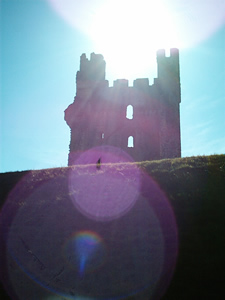
East tower seen from the outer ditch [Enlarge]
View map (SE 611 836): Multimap | Google | Live Local
Although Walter l'Espec, founder of the nearby Rievaulx Abbey, had a castle at this site what remains today is due mainly to Robert de Roos (also known as Furfan) from the late twelfth century, and later additions. The earthworks are quite possibly l'Espec's though. The castle is now quite ruinous, not least due to a severe slighting at the end of a three month long civil war seige in 1644, when it fell to Sir Thomas Fairfax. The barbican, western range, western tower and the large east keep-tower still more or less stand however and the extensive earthworks, partly cut from the solid rock, also survive.
The aforementioned earthworks form a large double ditch surrounding the castle's rectangular bailey. This bailey was protected by a curtain wall with round towers at three corners, a gatehouse occupying the south-east corner. A further, stronger entrance was present at the north, flanked by semicircular towers. The castle was further strengthened in the mid-thirteenth century either by Robert's son William (Pettifer) or by his grandson Robert de Roos III (Coppack) building an outer gatehouse in front of the northern entrance and a large barbican before the south-east gate.
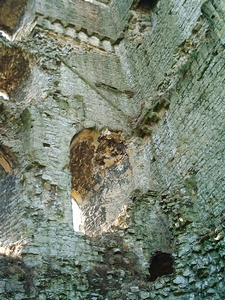
Interior of the eastern tower-keep. The original roofline is visable, as are corbels for the added floors. [Enlarge]
The keep is one of the most interesting features of Helmsley, though sadly its outer portion was blasted down in the civil war slighting, the inner wall still stands to its full height. At a time when round towers were becoming popular, this keep tries in its shape to combine the best defensive features of the new vogue with the domestic convenience of a more tradition rectangular tower. Originally only an undercroft and room above (possibly a chapel), the additional two stories and the turrets on top were added by William de Roos, around about 1300. The addition to the keep is clearly marked by the change from the original material to the later sandstone and internally the original roofline and traces of the wall-walk and crenellations can be clearly made out. When the tower was increased in size the original upper chamber was divided into two by the insertion of a stone vault (the springers for which remain) and an additional storey built ontop. This led to much alteration of windows and doorways and addition of stairways so that it is now somewhat difficult to appreciate the construction of the ruined tower. The floor of the new storey is marked by a series of corbels which carried a wooden plate around the building. The situation was further complicated when the upper floors were drastically altered following a fire in the late fourteenth century. This led to a stone vault replacing the wooden floor of the third storey, resulting in this floor being effectivly lowered. An external garderobe was added to the upper floor, reached by a mural passage.
William also increased the domestic accomodation, adding stone buildings along the western range, altering the western tower, and building a substantial new hall to the south-east. This hall came complete with kitchen, pantry and buttery. This replaced the twelfth century hall of the western range and was linked to the private accomodation in the western tower and the buildings of the south-western range. The western tower's outer wall was actually moved outward allowing the insertion of a series of garderobes and a staircase. A wall across the bailey was added to effectivly divide the castle into one half for its lord and the other for the steward and household.
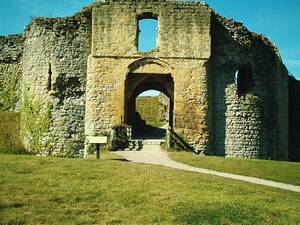
Gatehouse of the southern barbican. [Enlarge]
The southern barbican is a strong structure with two drum towers flanking a central gatehouse. Short lengths of wall from a curtain terminating in two further round towers. The gatehouse was protected by a portcullis and drawbridge. This led to the south gateway, itself protected by a portcullis and wooden doors. Access was also provided into the inner ditch. In the early fourteenth century flanking walls were added to connect the barbican to the original curtain. This included the addition of a round tower just to the east of the gateway. The northern barbican is less substantial than its southern counterpart. It consisted of a simple gate flanked by drum towers, the walls of which extended back across the bank separating the two ditches. A drawbridge spanned the outer ditch and access was again provided into the inner ditch. The northern gate behind was a portcullised passage flanked by two round towers.
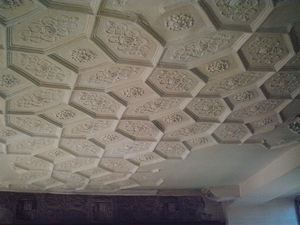
Ceiling within the tudor mansion which was built within the shell of the west range and tower. [Enlarge]
The western range remained in use after the castle's slighting and a Tudor manor house build by Edward Manners may now be found along the west range, incorporating the western mural tower. The foundations of the castle's hall may be seen near to this western range.
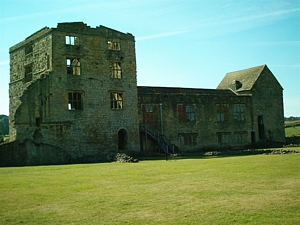
The western range and tower. [Enlarge]
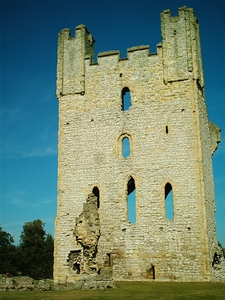
The east tower. The sandstone clearly delimits the later addition. [Enlarge]
Sources:
- Personal visit
- G. Coppack, Helmsley Castle: Guide Book, 2nd Ed., English Heritage (1997) ISBN:1 850742 91 X
- A. Pettifer, English Castles: A Guide by Counties, Boydell & Brewer, Woodbridge (1995) ISBN: 0 85115 782 3
- N. Harris, Castles of England, Scotland and Wales, George Philip, London (1991) ISBN: 0 7537 0753 5
- CastleXplorer
- The Heritage Trial
Photograph Gallery (yet more photos!)